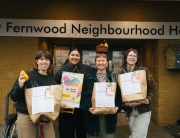>> Mark Dusseault
The Belfry Theatre has been producing shows in Fernwood for four decades; the rich history of the building spans 130 years.
In the last 40 years, over two million people have ventured into Fernwood and crossed our threshold. Some have come to laugh, and some to cry. All have come to share a few hours in the dark with friends and strangers to listen to a story and to learn a little bit more about what it means to be human.
The Belfry has experienced its share of ups and downs. We’ve produced and premiered plays that have gone on to international success in far-flung places like Melbourne and Sydney, London and Berlin, San Francisco and Kamloops.
We’ve also produced a few “turkeys”—plays we never mention by name. And we’d prefer you didn’t, either. The magic of theatre is when the stars align. The experience can’t be beaten.
The whole experience can be summed up in this scene from the film Shakespeare in Love:
Philip Henslowe: Mr. Fennyman, allow me to explain about the theatre business. The natural condition is one of insurmountable obstacles on the road to imminent disaster.
Hugh Fennyman: So what do we do?
Philip Henslowe: Nothing. Strangely enough, it all turns out well.
Hugh Fennyman: How?
Philip Henslowe: I don’t know. It’s a mystery.
And when the stars don’t align? When there is no mystery? Well, that’s part of being human. Things don’t always go our way, in life or in the theatre.
Thankfully, things have gone our way. The Belfry is a success because of two things; the building and people.
The Belfry started life in Fernwood in 1887 as the Spring Ridge Chapel (Spring Ridge being what Fernwood was called back then; today the Chapel serves as our lobby). Fifteen burgeoning Baptists were enticed by cheaper land prices outside of the city and built the Chapel. We say “burgeoning” as it wasn’t until a few years later that the congregation was officially recognized as the Emmanuel Baptist Church.
It truly was a case of a few individuals believing in something they felt needed to be done.
By 1892, the Baptists were booming and they built the Sanctuary (it now houses our Mainstage theatre) and continued to be a mainstay in the community until the 1970s.
Upheaval was a way of life in Fernwood in the 1970s. The church congregation moved and the building sat empty until the enterprising Cool-Aid Society saw an opportunity to turn part of the building into a youth hostel.
After a few years and under much opposition, including two fire-bombing incidents, Cool-Aid turned its youth hostel into a homeless shelter—sadly then, as today, a much-needed facility.
Cool-Aid only used two-thirds of the building for their services—the Chapel served as the women’s dormitory, plus medical, dental, and administrative offices. The back of the building, a gymnasium built in the 1950s, served as the dining hall and men’s dormitory.
That left the Sanctuary empty, until a couple of aspiring theatre artists decided it could be used as a performance and rehearsal space. In 1974, the Spring Ridge Cultural Centre was born.
It was a rocky start. At the time there were few government funds available for presenting houses (or road houses, as we call them—venues that just rent their space to touring artists).
But funding was available for producing houses, so in December of 1975 the space was renamed the Belfry and given a mandate to produce contemporary plays with a focus on new Canadian work.
Magic struck immediately. Four gentlemen (and we use that term loosely) put up $8000 to mount the Belfry’s first show, Puttin’ on the Ritz. It was a huge hit and eventually toured to Vancouver and the Stratford Festival.
The four, who collectively called themselves The Quack, the Dwarf, the Pornographer and the Drunk (it was another era, folks, we’re just doing the reporting), made their money back and promptly reinvested it the Belfry’s next show.
They lost everything—but the theatre survived. One of the original investors, a part-time rancher at the time, said “My father told me to never invest in anything that eats while you sleep. I chose cows and theatre and failed on both accounts.”
Over the next fifteen years, the Belfry experienced tremendous growth and horrendous lows, coming to close to closing more times than anyone cares to remember.
One turning point, in 1990, was Cool-Aid’s announcement that they were moving to new premises downtown. In the intervening years they had bought the building and it was now up for sale.
The Belfry, in the best financial position it had been in years, decided to raise the funds, buy the building, and begin what would turn out to be twelve years of renovations to restore the nineteenth-century church.
That decision sparked a renaissance at the Belfry. For the first time the theatre had everything in one place. The carpentry, wardrobe, and props workshops, as well as the rehearsal hall and theatre, were all under one roof. Plus there was a lobby, and patrons didn’t have to line up in Fernwood Square and the staff didn’t have to have meetings on the stairs to the balcony.
With more space, the theatre could mount more productions, workshop new plays, develop high school programs, and engage in new audience enrichment activities.
As the Belfry grew, so did our audience, our volunteer base (300 people donate thousands of hours to the theatre each year), and our donor list (those kind folks who donate money to the theatre year in and year out).
This year we’re celebrating all of those people who have made an impact in their community, those who believed something needed to be done and did it.
We’re also celebrating forty years of incredible theatre in this little part of Victoria, where two million people have come together to laugh, to learn, to be entertained, and to be in one another’s company, sitting in the dark and learning about what it means to be human.






